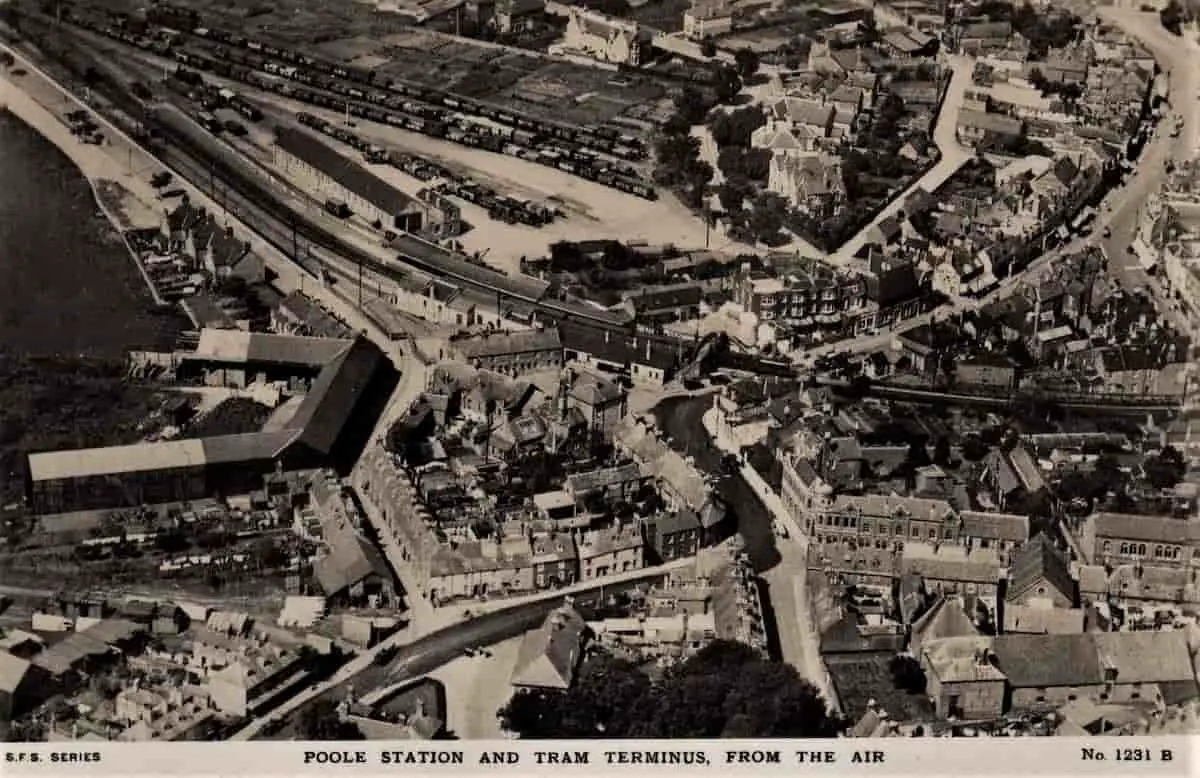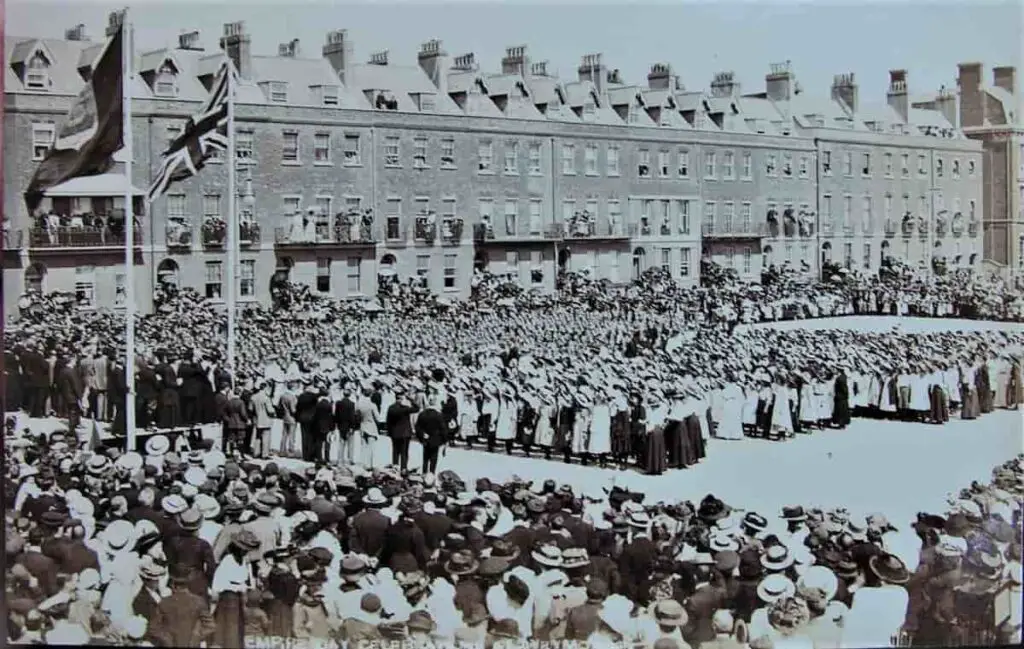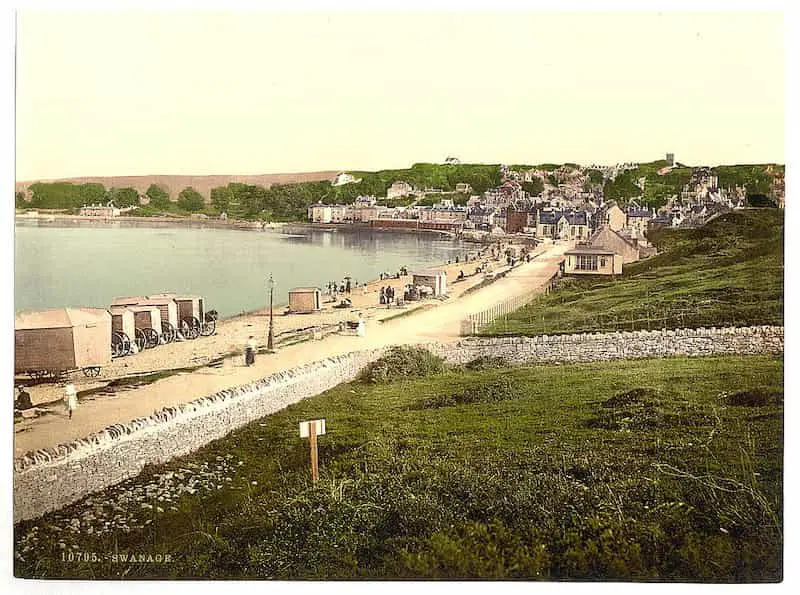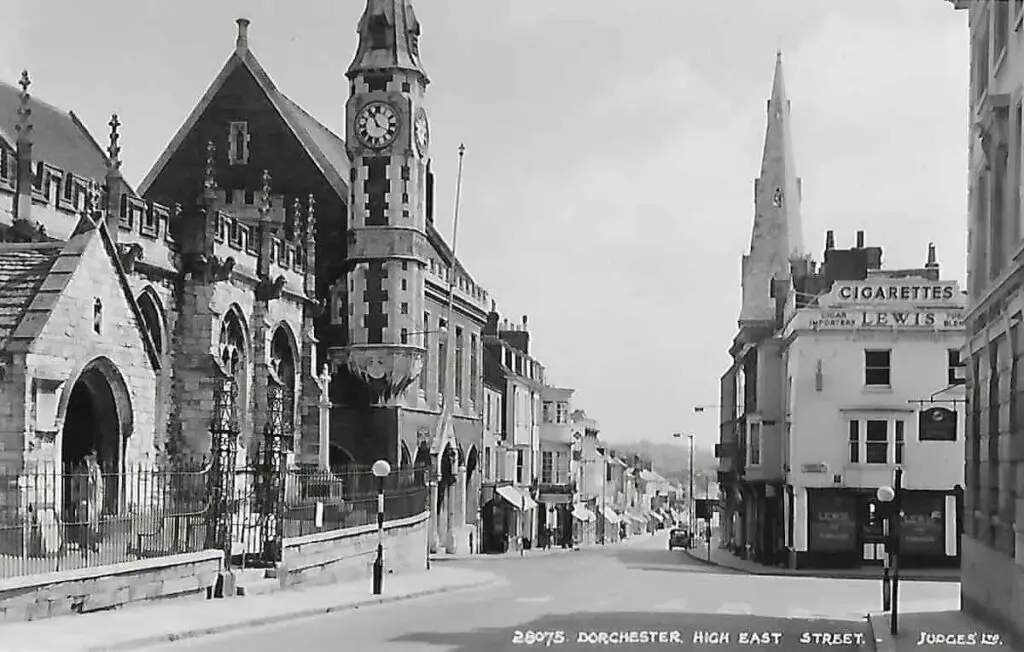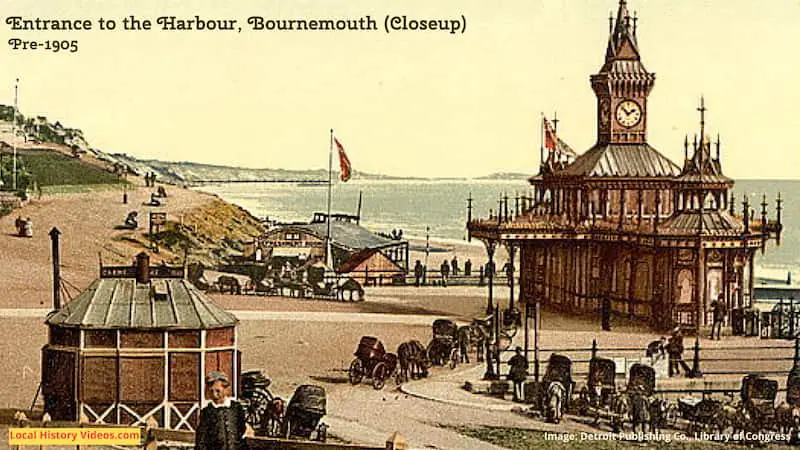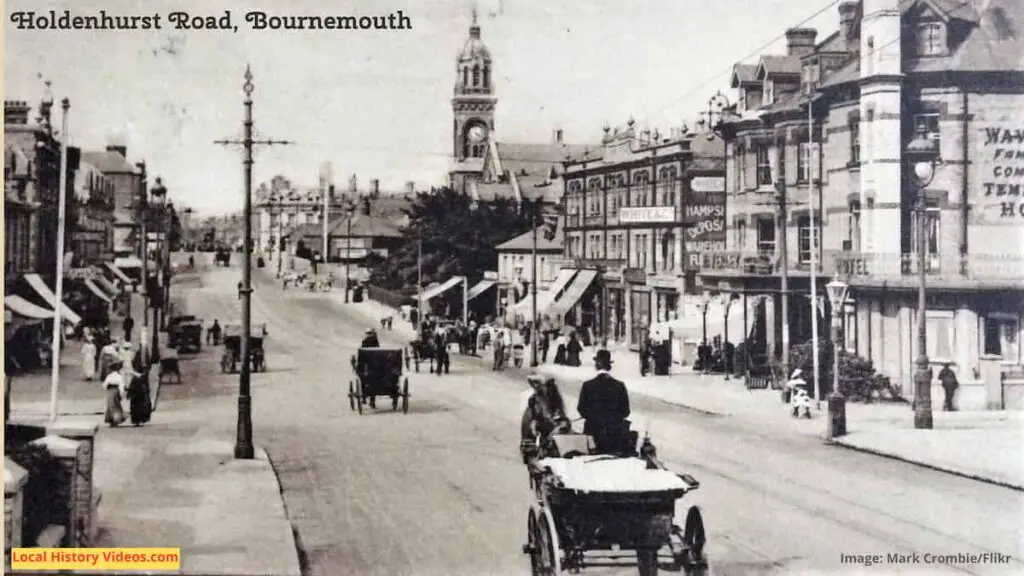Glimpse history through old images of Poole, in Dorset, England, UK.
Old Photos of Poole
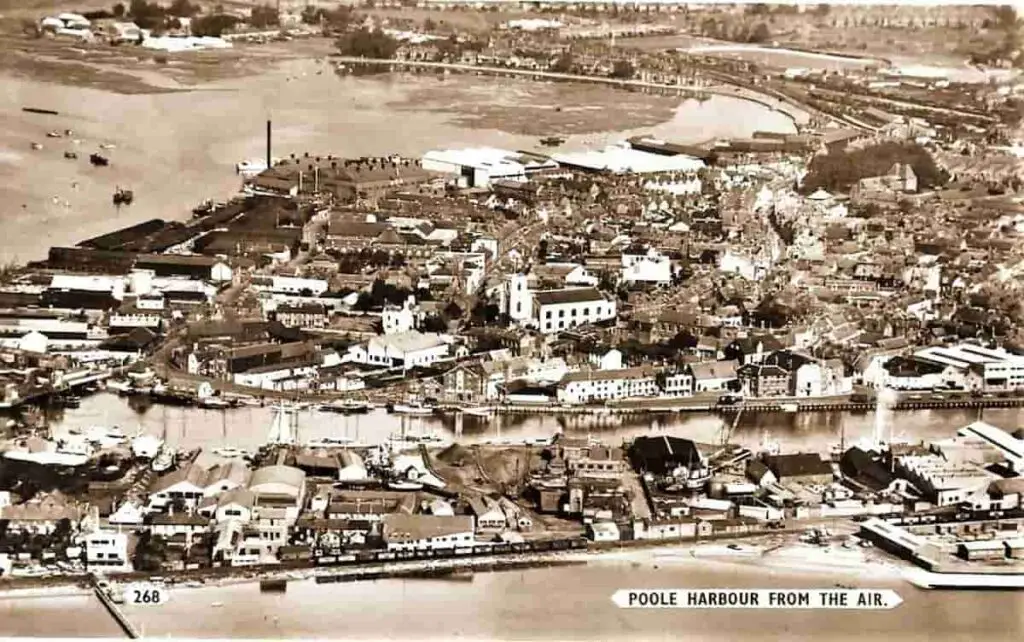
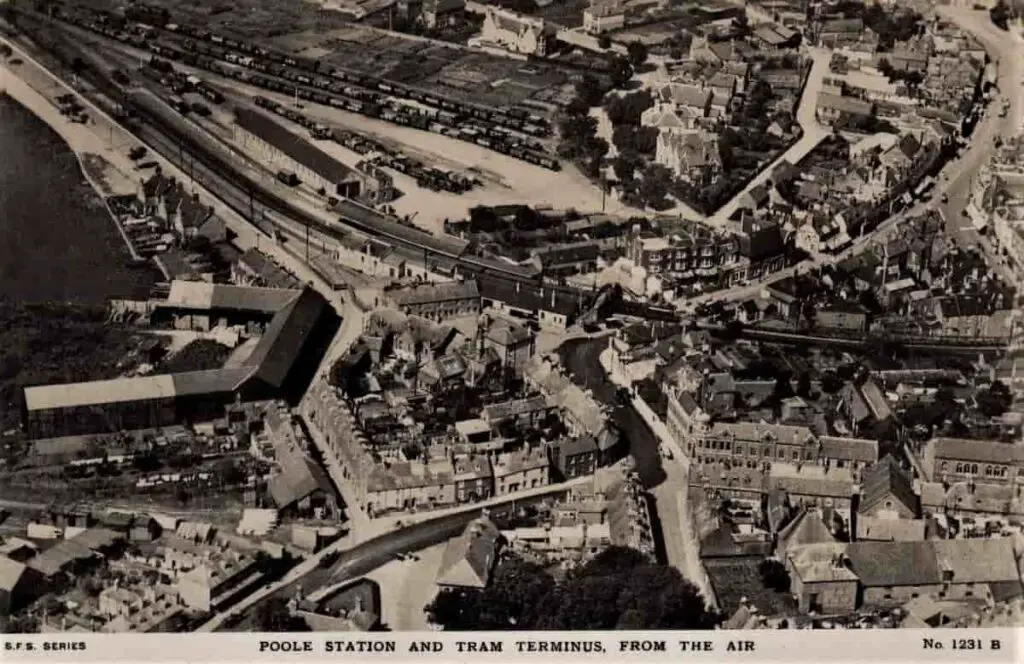
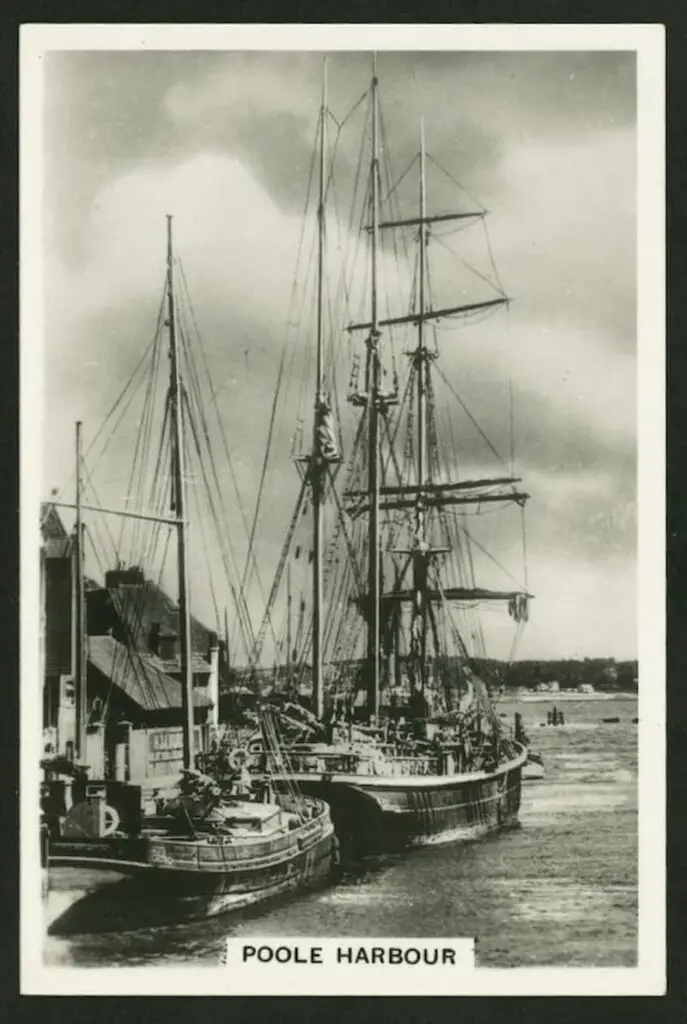
Poole in World War I
Sometime between 1914 and 1918, a captured or surrendered German U-boat was displayed in towns along England’s south coast.
Visitors paid for the chance to look at one of these deady submarines up close, raising money for charity.
Footage recorded to show the U-boat and the long line of peope waiting to board it luckily also included a great shot of the buildings along the waterline at that point in time.
U-Boats Visit The South Coast (1914-1918) – British Pathé on YouTube
Poole in 1938
Poole Issue Title Is Good Health (1938) – British Pathé on YouTube
Poole Harbour in 1951
Ceremony includes Beating the Bounds at Poole Harbour (1951) – British Pathé on YouTube
Poole Harbour’s Postman in 1964
This entertaining newsreel introduces the work routine of young Alan Marsh, whose six-days-a-week job delivering newspapers, bread and milk to the islands of Pool Harbour began at the age of 18.
Water Postman (1964) – British Pathé on YouTube
Poole General Hospital in 1968
This footage begins with a group of trainee nurses under instruction from a doctor, who then goes on his rounds.
Hospital At Poole (1968) – British Pathé on YouTube
A Bit of Poole History
extract from:
The History of the Town and County of Poole
by John Sydenham
Published in 1839
Pages 430 – 439
POLICE OFFICE.
The police of the town, both daily and nightly, is very well conducted. It was formerly managed, conjointly with the lighting, by the commissioners appointed under the provisions of the local act of the 29th Geo. II.; but, by the corporation act of the 5th and 6th Wm. IV., c. 76, the police of the borough was made subject to its provisions, and brought under the regulation of the town council. There are now six daily, and six nightly police; with a day superintendent, and a night superintendent. Since this alteration in the system, a private house in Hill Street has been converted into a police office, in which the minor business connected with that establishment is conducted.
GAS WORKS.
The town of Poole has been lighted with gas for the last four years. The lighting is governed by the commissioners under the local act just mentioned. This act provides that the mayor and justices of the peace of the town and county of Poole, for the time being, and eleven of the principal inhabitants of the town, to be chosen annually on Easter Tuesday, by the inhabitants in vestry assembled, shall be commissioners for the purposes of the act, in regard to lighting the streets of the town, etc., to which end the commissioners are vested with power to appoint assessors to make an annual rate or assessment on the inhabitants, which is termed the lamp rate.
Down to the year 1833, the streets of Poole were lighted with oil; but in that year a gas company was founded, and the commissioners have since contracted for a due supply of gas. The works have been erected on a convenient site, on the south-eastern side of the town. The company is formed by shareholders, there being 400 shares, at £10 each. The affairs of the company are proceeding very favorably, as nearly all the shops and inns, and many of the private houses in the town are supplied by the company. All the capital was required for the erection of the works and the completion of the establishment; but the returns have since been so abundant as not only to provide for an annual dividend of 5 per cent. to the shareholders but to have enabled the directors to contemplate a reduction in the price of gas supplied to the private consumers.
The number of public lamps is 168, of which 134 are paid for from the proceeds of the lamp rate, and 34 for lighting the quays are provided out of the quay dues. A lamp rate of 6d. in the pound per annum is sufficient to provide the necessary funds.
THE LIBRARY.
The Town and County of Poole Library is situated at the lower extremity of the High street, near the quay. This institution was founded in the year 1830, when the site, on which the building has been erected, was presented by Benjamin Lester Lester, esq., and the costs of the erection were defrayed by the hon. W. F. S. Ponsonby, those gentlemen being then the representatives of the borough. The room containing the library is lofty, sufficiently large, and well adapted to the purpose. The institution is supported by donations and annual subscriptions. The property is declared to be in those who have made donations of ten pounds or upwards, they also becoming annual subscribers: donors of five pounds also become proprietors when their annual subscriptions, added to their donations, shall amount to ten pounds; and annual subscribers become proprietors when the aggregate amount of their subscriptions shall amount to fifteen pounds: but no proprietor is to continue entitled to a share in the property after the discontinuance of his annual subscription. The property, of every description, is vested in trustees, who stand possessed of the same on certain trusts declared in the deed. The trustees, with a committee of nine subscribers, annually chosen by ballot, have power to make laws and regulations for the management of the institution. A treasurer and a secretary are appointed by the trustees and chosen out of the proprietors. The annual subscription to the library is one guinea, and the subscribers are admitted by ballot. The number of subscribers is not so great as might have been anticipated from the extent of the population of the town and its neighbourhood. The number of books now belonging to the institution does not exceed 1700, and, from the circumstance just mentioned, additions are not made to any considerable extent.
Strangers are admitted to the reading room on the introduction of a member.
The front of the building bears the following inscription: – “Public Library. The gift of Benjamin Lester Lester, esquire, and the honble. W. F. S. Ponsonby, representatives of Poole in parliament. 1830.”
THE TOWN HOUSE.
This building has been erected for the convenience of merchants and others, as a newsroom and a place of general resort. It is supplied with the leading London daily journals, provincial newspapers, and other periodical publications. Subscribers are admitted by ballot. The subscription is two pounds per annum. The present townhouse was erected in 1822, on the quay, on the site of the structure which had been built in 1727, for the same purpose. Over the entrance is sculptured, in bas-relief, a likeness of Benjamin Skutt, esq., in whose mayoralty the old townhouse was founded, to which he was one of the principal contributors. The reading and newsroom are on the first floor, and in addition to the newspapers, etc., it is furnished with numerous maps. Over the fireplace is a very fine painting of King Charles II., in his robes of state, supposed to have been presented to the society by Mr. Skutt, whose grandfather was in close attendance upon and much favored by that monarch during his visit to Poole. Underneath this room is the office of the collector of the quay and harbor dues.
The premises are held under a license from the corporation, dated May 1, 1822, granted to George Welch Ledgard and others for 999 years, at the yearly rent of three guineas. And, of the same date, is a declaration of trust by the said George Welch Ledgard and others, trustees, reciting that the said license was granted to them at the request of the subscribers or society of the townhouse, the commissioners for watching and lighting the town, and the treasurer of the quay dues, and then declaring the trusts to be observed.
TOWN CELLARS.
The large building on the quay, known as the town cellars, and which has been used for centuries as a place for the temporary deposit of goods brought to the town, is of considerable antiquity but so mutilated by time, violence, and alterations that it is difficult to trace in the structure itself the characters of its original use. It has been conjectured that the general architectural features bear indications that the building was formerly devoted to ecclesiastical purposes, but no sufficient evidence can be adduced in support of this supposition, and it is more probable that the edifice was raised by the ancient lords of the manor as a hall for their accommodation when visiting their burgh of Poole or as a storehouse for the deposit of the goods imported here on their account and of the corn and other merchandise taken by them as toll. That it was used as a storehouse so early as the commencement of the fifteenth century is clear from the account of the attack by the Spanish privateers, given ante [p. 92]. It is spoken of in the Spanish chronicle as a “large building,” a “storehouse,” “full of arms and sea stores of all kinds.” It is now held of the manor; and it was leased to the corporation so long since as the middle of the sixteenth century, and by that body was used as a storehouse for merchandize brought to the port, and on which they made a charge for cellarage, according to an ancient scale, of which a copy is still extant. A view of this building is given p. 148.
THE MARKET.
It has been already stated that the open arcades beneath the guildhall have been appropriated to the purposes of a meat market; but these having been found insufficient to afford due accommodation, a large space adjoining was set apart and covered in as an additional market place; and want of accommodation being still felt, another extensive spot, on the north side of the Unitarian meeting house, was, in 1827, appropriated, with convenient sheds and a neat entrance, as a fruit, vegetable, and butter market.
The markets of Poole are very well supplied, in regard both to the quantity and quality of the meat, vegetables, etc., brought for sale, and the prices in general are considerably lower than those of other markets. The market days are Monday and Thursday. The fairs, of which each excites the juvenile inhabitants of the town for eight days, are held annually on the feast of St. Philip and St. James (May 1) and seven days following, and on the feast of All Souls (November 2) and seven days following.
The fish market is holden in a modern edifice, built for the purpose on the quay. It is not well supplied. The tolls of the markets and fairs, which are vested in the corporation, are at present leased at the sum of £250 per annum. A pitched corn market was formerly held in Poole, in the open space, still known by the appellation of “the corn market,” in the high street. In 1699, sheds were erected here for the convenience of the dealers, but these have long since vanished, and the market has been discontinued for a great many years past.
THE WORKHOUSE.
The house used as a workhouse is situated in west street. The following inscription, borne on the front of the building, states it to have been erected from the munificence of Thomas Missing, esq: – “How commendable are the works of charity. This publick edifice, erected for the reception of the poor, was finished in the year 1739; the necessary charges of building it, amounting to £500, were voluntarily defrayed by the sole generosity of Thomas Missing, esq.”
A question was raised some years since by the corporation, as to the property of the site of the building, but no documents to clear the point could be produced. The ground has been in the possession of the parish at least since 1739, and does not appear to have been the subject of any charitable endowment, either by Mr. Missing (who represented the borough), or any other person.
Until the passing of the poor law amendment act, in 1834, and the consequent formation of a union, comprising the parish of Saint James, and the adjoining parishes and tithings, the house in west street was amply sufficient for the purposes of the parish; but the accommodation not being sufficiently extensive for the whole union, a new house is about to be erected on a spot of ground in Longfleet.
The great object of our early pauper legislation appears to have been the restraint of vagrancy. The earliest scheme of a provision for the poor sanctioned by the legislature, was by means of regular collections, which, in the course of a long series of statutes, ending in the 43rd Elizabeth, were almost insensibly converted into compulsory assessments.
Various modes of supplying the wants of the indigent prevailed in different parts and at different periods. And a practice formerly existed in this port, of levying the tenth part of all grain shipped here, for the relief of the poor of the town. This practice appears to have been resisted after the passing of the act 43rd Elizabeth, but by orders received from the lord high treasurer of the kingdom, by command of the privy council, dated December 22, 1603, and in October, 1604, it was directed that the tenth quarter of grain, should be set aside for the relief of the poor as formerly.
In an old book in the town chest, entitled “a booke for the accompts of the overseers of the powre of the parryshe towne and countie of Poole,” there are some curious entries. This book commences under date of 1598, and is continued to 1624.
In 1598-9, the whole of the receipts appear to have consisted of donations, bequests, and 28s. taken out of “the poor man’s box.” The payments were chiefly sums paid as premiums with apprentices. With John Russell, who was apprenticed for nine years, a premium of 40s. was paid.
In 1601, the overseers say that they “have gathered in the churche upon the book for the relieffe of the poore for three quarters of a yeare, their accompte being for no more, £9 15s. 6d.,” of which there was paid to the poor, £9 15s. This “book” must have been the first rate levied under the 43rd Eliz. The sum collected offers a striking contrast to some of the annual amounts levied in late years.
In 1602, is this entry, “collected in the churche this yeare towards the reliefe of the poore, £11 4s. 11d.”
In 1604, nearly all the sums “disbursed towards the weakly reliefe of the poore of this town,” are stated to have been paid to paupers in sickness.
- The total amount of payments this year was £17 7s. 2d.
In 1611, they amounted to £21 13s. 11d.
In 1616, the ordinary weekly payments are stated at £18 12s. 10d.; and the extraordinary payments, as premiums with apprentices, allowances to sick people, & c., at £10 10s. 7d., making a total of £29 3s. 5d.
The state of the parochial affairs of Poole, immediately prior to the recent formation of the parochial union, may be gathered from the following extract from the report.
Furnished by D. O. P. Okeden, esq., who, as one of the assistant commissioners of inquiry, visited the parish in 1832.
“Poole is a town and county, having its own quarter sessions and gaol. It is entirely governed by its own magistracy, without any interference of the magistrates of the county.
“Population, 6459.
“Annual sum expended on the poor for the year ending Lady-day, ..1830,
Ditto ..1831,
Ditto ….. … 1832,
£ s . d .
3265 8 6
3149 13 0
3440 17 6
“There is but one parish in Poole, St. James’s; Poole is governed, as to the management of its poor, by the Gilbert act.
“The assistant overseer has £ 30 per annum. The guardian acting, Mr. Hooper, who is the entire manager of all that relates to the poor, has £ 130.
“The acting guardian and visiters settle the relief to be allowed to each pauper. There is scarcely ever an appeal to the magistrates.
“The Workhouse. – The numbers, ages, and sexes of the inmates of the workhouse are at present, December, 1832,
…. 42
“Old and infirm men, some above 90,
…. 37
Ditto women, three above 92 ..
Under 13 years old, boys,.
Ditto, girls, ….
21
29
Total inmates, 129
“There are generally about five or six more, somewhat younger than the old men and women, who do the work of the establishment.
“The women are mostly widows. The men have been sailors and mechanics. The old men occasionally pick a little oakum, and some of the less infirm sweep and clean the streets. These employments may save the parish
about £40 per annum.”
” The men and women are separated, except in the case
(there are only two cases) of an old married couple.
” The board, lodging, clothes, fuel, and all expenses of
the house, and medical advice, for each individual,
amounts to a sum not exceeding 3s. 10d. per week.
” The children are well instructed, go to the Sunday schools, and to church or meeting house. The boys are apprenticed to the sea line. There is a very accurate and constant visitation of the out-poor at their houses, and every means are used to ascertain their characters, and the validity of their claims on parish aid. The men, of the out-poor, are principally old sailors and some mechanics: the women, widows of those classes with families. When they have fathers or children able to support them, the parish does not relieve the poor, but apply for, and procure from the magistrates, an order on the relations.
” If able-bodied men apply for relief, they are sent to the parish farm. Such applications are rare, and the applicants soon find work again.
” About one-tenth of the resident poor are non-parishioners. The total number of poor relieved out of the workhouse is generally 700. The residences of the poor
are rated, but the rates never demanded. There is a loss of about one-third on every rate on this item, as the landlords are not made to pay the rates.”
Find a digital copy of this book

